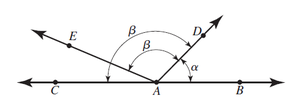개요[편집 | 원본 편집]
절대 기하학의 한 정리로, 평각(=180°)에 관해 다루기 때문에 반드시 알아야 하는 정리이다. 파슈의 공리와 마찬가지로 공리로써 받아들이는 경우도 있지만, 일반적인 절대 기하학의 공리 체계에서는 증명이 가능한 명제로서 등장한다. 본격적인 정리에 들어가기 전에, 몇 가지 정의를 짚고 넘어가자.
- 두 각 [math]\displaystyle{ \angle{BAD},\,\angle{DAC} }[/math]에 대해, 두 반직선 [math]\displaystyle{ \overrightarrow{AB},\,\overrightarrow{AC} }[/math]가 서로 반대[1]라면, 이 두 각은 선형 쌍(Linear pair)를 이룬다고 한다.
- 앞서 말했듯이, 평각=180°
- 두 각의 합이 평각이면, 두 각은 보각(Supplementary) 관계에 있다고 한다.
평각 정리란, 두 각이 선형 쌍을 이루면 두 각은 보각 관계라는 내용이다. 직관적으로 생각하면 굉장히 당연하지만, 그것을 증명하는 것은 별개의 문제. 증명에 앞서, 한 가지 보조 정리를 알고 넘어가자.
보조 정리[편집 | 원본 편집]
[math]\displaystyle{ C*A*B }[/math]이고, [math]\displaystyle{ D }[/math]가 [math]\displaystyle{ \angle{BAE} }[/math]의 내부에 있으면, [math]\displaystyle{ E }[/math]는 [math]\displaystyle{ \angle{DAC} }[/math] 내부에 존재한다.
[math]\displaystyle{ E }[/math]가 [math]\displaystyle{ \angle{DAC} }[/math]에 존재한다는 것을 보이려면, [math]\displaystyle{ E }[/math]와 [math]\displaystyle{ D }[/math]가 [math]\displaystyle{ \overleftrightarrow{AC} }[/math]를 기준으로 같은 반평면에 있고, [math]\displaystyle{ E }[/math]와 [math]\displaystyle{ C }[/math]가 [math]\displaystyle{ \overleftrightarrow{AD} }[/math]를 기준으로 같은 반평면에 있다는 것을 보이면 된다.
[math]\displaystyle{ D }[/math]가 [math]\displaystyle{ \angle{BAE} }[/math] 내부에 존재하므로, [math]\displaystyle{ E }[/math]와 [math]\displaystyle{ D }[/math]가 [math]\displaystyle{ \overleftrightarrow{AB} }[/math]를 기준으로 같은 반평면에 있다. 그런데 [math]\displaystyle{ C*A*B }[/math]이므로, [math]\displaystyle{ \overleftrightarrow{AB}=\overleftrightarrow{AC} }[/math]. 또한, 크로스바 정리에 의해 [math]\displaystyle{ \overrightarrow{AD} }[/math]는 [math]\displaystyle{ \overline{BE} }[/math]와 만난다. 따라서, [math]\displaystyle{ E }[/math]와 [math]\displaystyle{ B }[/math]는 [math]\displaystyle{ \overleftrightarrow{AD} }[/math]를 기준으로 반대 반평면에 속해있다 (평면 분할). 그런데 [math]\displaystyle{ C*A*B }[/math]이므로, [math]\displaystyle{ C }[/math]와 [math]\displaystyle{ B }[/math] 역시 [math]\displaystyle{ \overleftrightarrow{AD} }[/math]를 기준으로 반대 반평면에 속해있다. 따라서, [math]\displaystyle{ E }[/math]와 [math]\displaystyle{ C }[/math]는 [math]\displaystyle{ \overleftrightarrow{AD} }[/math]를 기준으로 같은 반평면에 속해있다.
평각 정리[편집 | 원본 편집]
[math]\displaystyle{ \angle{BAD} }[/math]와 [math]\displaystyle{ \angle{DAC} }[/math]가 선형 쌍을 이루면, [math]\displaystyle{ \angle{BAD}+\angle{DAC}=180 }[/math]이다.
[math]\displaystyle{ \angle{BAD} }[/math]와 [math]\displaystyle{ \angle{DAC} }[/math]가 선형 쌍을 이루기 때문에, [math]\displaystyle{ \overrightarrow{AB} }[/math]와 [math]\displaystyle{ \overrightarrow{AC} }[/math]는 서로 반대이다. 먼저, 증명을 간단히 하기 위해 [math]\displaystyle{ \angle{BAD}=\alpha }[/math], [math]\displaystyle{ \angle{DAC}=\beta }[/math]라고 가정하자. 삼분법칙에 의해, [math]\displaystyle{ \alpha+\beta }[/math]는 180보다 작거나, 같거나, 크다.
먼저, [math]\displaystyle{ \alpha+\beta\lt 180 }[/math]이라고 가정하자. 그럼, 각도 작도 공준에 의해 [math]\displaystyle{ \overleftrightarrow{AB} }[/math]를 기준으로 [math]\displaystyle{ D }[/math]와 같은 반평면에 속해있고, [math]\displaystyle{ \angle{BAE}=\alpha+\beta }[/math]인 점 [math]\displaystyle{ E }[/math]가 존재한다. 그러면 반직선 사이 정리에 의해, [math]\displaystyle{ D }[/math]는 [math]\displaystyle{ \angle{BAE} }[/math]의 내부에 존재한다. 따라서, 각도 합 공준에 의해 [math]\displaystyle{ \angle{BAD}+\angle{DAE}=\angle{BAE} }[/math]이고, [math]\displaystyle{ \angle{DAE}=\beta }[/math]임을 알 수 있다. 한편, 위 보조 정리에 의해 [math]\displaystyle{ E }[/math]는 [math]\displaystyle{ \angle{DAC} }[/math]의 내부에 존재한다. 따라서, 각도 합 공준에 의해 [math]\displaystyle{ \angle{DAE}+\angle{EAC}=\angle{DAC} }[/math]. 곧, [math]\displaystyle{ \angle{EAC}=0 }[/math]이고, 이는 각도 공준에 모순이다. 따라서 [math]\displaystyle{ \alpha+\beta\lt 180 }[/math]일 수 없다.
이제, [math]\displaystyle{ \alpha+\beta\gt 180 }[/math]이라 가정하자. 그럼, 각도 작도 공준에 의해 [math]\displaystyle{ \overleftrightarrow{AB} }[/math]를 기준으로 [math]\displaystyle{ D }[/math]와 같은 반평면에 속해있고, [math]\displaystyle{ \angle{BAF}=\alpha+\beta-180 }[/math]인 점 [math]\displaystyle{ F }[/math]가 존재한다. 그러면 반직선 사이 정리에 의해, [math]\displaystyle{ F }[/math]는 [math]\displaystyle{ \angle{BAD} }[/math]의 내부에 존재한다. 따라서, 각도 합 공준에 의해 [math]\displaystyle{ \angle{BAF}+\angle{FAD}=\angle{BAD} }[/math]이고, [math]\displaystyle{ \angle{FAD}=180-\beta }[/math]임을 알 수 있다. 한편, 위 보조 정리에 의해 [math]\displaystyle{ D }[/math]는 [math]\displaystyle{ \angle{FAC} }[/math]의 내부에 존재한다. 따라서, 각도 합 공준에 의해 [math]\displaystyle{ \angle{FAD}+\angle{DAC}=\angle{FAC} }[/math]. 곧, [math]\displaystyle{ \angle{FAC}=180 }[/math]이고, 이는 각도 공준에 모순이다. 따라서 [math]\displaystyle{ \alpha+\beta\gt 180 }[/math]일 수 없다.
삼분법칙에 의해, 가능한 경우는 [math]\displaystyle{ \alpha+\beta=180 }[/math]인 경우 뿐이다.
각주
- ↑ [math]\displaystyle{ \overrightarrow{AB}\neq\overrightarrow{AC} }[/math]이지만 [math]\displaystyle{ \overleftrightarrow{AB}=\overleftrightarrow{AC} }[/math]인 경우


